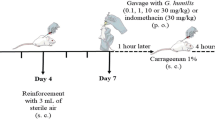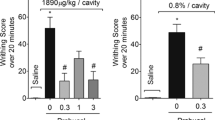Abstract
Several in vivo immunotropic effects of κ/β-carrageenan isolated from the red algae Tichocarpus crinitus were studied, by orally administering it at 100 mg/kg/day to mice for 7 days. Serum levels of IFN-γ, IL-12, IL-1β, and IL-4 were measured. Carrageenan’s ability to influence development of LPS-induced inflammation was also assessed. Oral administration of κ/β-carrageenan increased serum levels of all the studied cytokines at least twice in comparison to the intact mice, while intraperitoneal LPS injection at 1 mg/kg increased concentration of only the pro-inflammatory cytokines: IFN-γ, IL-12, and IL-1β. Furthermore, κ/β-carrageenan demonstrated a higher efficacy at inducing IFN-γ production than LPS. Previous 7-day-long oral carrageenan administration impaired development of LPS-induced inflammation: level of IL-1β dropped below that found in intact mice, while IFN-γ and IL-12 concentrations were at least 40% lower than in mice with LPS-induced inflammation. Murine peritoneal macrophages were also affected by the oral administration of the κ/β-carrageenan: their motility was increased, and morphology altered. In sum, we have demonstrated that κ/β-carrageenan, when administered orally, is not only not immunologically inert, but at the dose of 100 mg/kg possesses pharmacologically exploitable effects.

Similar content being viewed by others
References
Knutsen, S.H., D.E. Myslabodski, B. Larsen, and A.I. Usov. 1994. A modified system of nomenclature for red algal galactans. Botanica Marina: 37 Available from: https://www.degruyter.com/view/j/botm.1994.37.issue-2/botm.1994.37.2.163/botm.1994.37.2.163.xml.
Guibet, M., S. Colin, T. Barbeyron, S. Genicot, B. Kloareg, G. Michel, et al. 2007. Degradation of λ-carrageenan by Pseudoalteromonas carrageenovora λ-carrageenase: a new family of glycoside hydrolases unrelated to κ- and ι-carrageenases. The Biochemical Journal 404: 105–114 Available from: https://portlandpress.com/biochemj/article/404/1/105-114/41917.
Craigie, J. 1990. Cell walls. In Biol red algae, ed. K.M. Cole and R.Y. Sheath, 221–257. Cambridge: Cambridge University Press.
Barabanova, A.O., I.M. Yermak, V.P. Glazunov, V.V. Isakov, E.A. Titlyanov, and T.F. Solov’eva. 2005. Comparative study of carrageenans from reproductive and sterile forms of Tichocarpus crinitus (Gmel.) Rupr (Rhodophyta, Tichocarpaceae). Biochem 70: 350–356 Available from: http://link.springer.com/10.1007/s10541-005-0121-4.
Shah, Z.C., and F.G. Huffman. 2003. Current availability and consumption of carrageenan-containing foods. Ecology of Food and Nutrition 42: 357–371 Available from: http://www.tandfonline.com/doi/abs/10.1080/03670240390265175.
Weiner, M.L. 2014. Food additive carrageenan: Part II: A critical review of carrageenan in vivo safety studies. Critical Reviews in Toxicology 44: 244–269 Available from: http://www.tandfonline.com/doi/full/10.3109/10408444.2013.861798.
Lahaye, M., and B. Kaeffer. 1997. Seaweed dietary fibres: Structure, physico-chemical and biological properties relevant to intestinal physiology. Sciences des Aliments.
Kilpatrick, D.C. 1999. Immunological aspects of the potential role of dietary carbohydrates and lectins in human health. European Journal of Nutrition 38: 107–117 Available from: http://www.ncbi.nlm.nih.gov/pubmed/10443332.
Ghosh, T., K. Chattopadhyay, M. Marschall, P. Karmakar, P. Mandal, and B. Ray. 2009. Focus on antivirally active sulfated polysaccharides: From structure–activity analysis to clinical evaluation. Glycobiology 19: 2–15 Available from: https://academic.oup.com/glycob/article-lookup/doi/10.1093/glycob/cwn092.
Pereira, M.G., N.M.B. Benevides, M.R.S. Melo, A.P. Valente, F.R. Melo, and P.A.S. Mourão. 2005. Structure and anticoagulant activity of a sulfated galactan from the red alga, Gelidium crinale. Is there a specific structural requirement for the anticoagulant action? Carbohydrate Research 340: 2015–2023 Available from: http://linkinghub.elsevier.com/retrieve/pii/S0008621505002788.
Zúñiga, E.A., B. Matsuhiro, and E. Mejías. 2006. Preparation of a low-molecular weight fraction by free radical depolymerization of the sulfated galactan from Schizymenia binderi (Gigartinales, Rhodophyta) and its anticoagulant activity. Carbohydrate Polymers 66: 208–215 Available from: http://linkinghub.elsevier.com/retrieve/pii/S014486170600124X.
Cicinskas, E., M.A. Begun, V.A. Tiasto, A.S. Belousov, V.V. Vikhareva, V.A. Mikhailova, et al. 2020. In vitro antitumor and immunotropic activity of carrageenans from red algae Chondrus armatus and their low-molecular weight degradation products. Journal of Biomedial Materials Research Part A 108: 254–266 Available from: https://onlinelibrary.wiley.com/doi/abs/10.1002/jbm.a.36812.
Bhattacharyya, S., H. Liu, Z. Zhang, M. Jam, P.K. Dudeja, G. Michel, et al. 2010. Carrageenan-induced innate immune response is modified by enzymes that hydrolyze distinct galactosidic bonds. The Journal of Nutritional Biochemistry 21: 906–913 Available from: http://linkinghub.elsevier.com/retrieve/pii/S0955286309001521.
Yuan, H., J. Song, X. Li, N. Li, and S. Liu. 2011. Enhanced immunostimulatory and antitumor activity of different derivatives of κ-carrageenan oligosaccharides from Kappaphycus striatum. Journal of Applied Phycology 23: 59–65 Available from: http://link.springer.com/10.1007/s10811-010-9536-4.
Yermak, I.M., A.O. Barabanova, D.L. Aminin, V.N. Davydova, E.V. Sokolova, T.F. Solov’Eva, et al. 2012. Effects of structural peculiarities of carrageenans on their immunomodulatory and anticoagulant activities. Carbohydrate Polymers 87: 713–720 Available from: http://linkinghub.elsevier.com/retrieve/pii/S0144861711007375.
Sokolova, E.V., Y. Karetin, V.N. Davydova, A.O. Byankina, A.A. Kalitnik, L.N. Bogdanovich, et al. 2016. Carrageenans effect on neutrophils alone and in combination with LPS in vitro. Journal of Biomedical Materials Research Part A 104: 1603–1609 Available from: http://doi.wiley.com/10.1002/jbm.a.35693.
Yermak, I.M., and Y.S. Khotimchenko. 2003. Chemical properties, biological activities and applications of carrageenans from red algae. In Recent Adv Mar Biotechnol, ed. M. Fingerman and R. Nagabhushanam, 207–255. CRC Press.
Kalitnik, A.A., S.D. Anastyuk, E.V. Sokolova, A.O. Kravchenko, E.I. Khasina, and I.M. Yermak. 2016. Oligosaccharides of κ/β-carrageenan from the red alga Tichocarpus crinitus and their ability to induce interleukin 10. Journal of Applied Phycology 28: 545–553 Available from: http://link.springer.com/10.1007/s10811-015-0577-6.
Kim, J.-K., M.L. Cho, S. Karnjanapratum, I.-S. Shin, and S.G. You. 2011. In vitro and in vivo immunomodulatory activity of sulfated polysaccharides from Enteromorpha prolifera. International Journal of Biological Macromolecules 49: 1051–1058 Available from: http://linkinghub.elsevier.com/retrieve/pii/S0141813011003473.
Sun, L., L. Wang, and Y. Zhou. 2012. Immunomodulation and antitumor activities of different-molecular-weight polysaccharides from Porphyridium cruentum. Carbohydrate Polymers 87: 1206–1210 Available from: http://linkinghub.elsevier.com/retrieve/pii/S0144861711007818.
Na, Y.S., W.J. Kim, S.M. Kim, J.K. Park, S.M. Lee, S.O. Kim, et al. 2010. Purification, characterization and immunostimulating activity of water-soluble polysaccharide isolated from Capsosiphon fulvescens. International Immunopharmacology 10: 364–370 Available from: http://linkinghub.elsevier.com/retrieve/pii/S1567576910000020.
Lee, J.-B., Y. Ohta, K. Hayashi, and T. Hayashi. 2010. Immunostimulating effects of a sulfated galactan from Codium fragile. Carbohydrate Research 345: 1452–1454 Available from: http://linkinghub.elsevier.com/retrieve/pii/S0008621510000844.
Kalitnik, A.A., P.A. Marcov, S.D. Anastyuk, A.O.B. Barabanova, V.P. Glazunov, S.V. Popov, et al. 2015. Gelling polysaccharide from Chondrus armatus and its oligosaccharides: The structural peculiarities and anti-inflammatory activity. Carbohydrate Polymers 115: 768–775 Available from: http://linkinghub.elsevier.com/retrieve/pii/S0144861714004275.
Hugerth, A.M. 2001. Micropolarity and microviscosity of amitriptyline and dextran sulfate/carrageenan-amitriptyline systems: The nature of polyelectrolyte-drug complexes. Journal of Pharmaceutical Sciences 90: 1665–1677 Available from: http://www.ncbi.nlm.nih.gov/pubmed/11745725.
Schmidt, A.G., S. Wartewig, and K.M. Picker. 2003. Potential of carrageenans to protect drugs from polymorphic transformation. European Journal of Pharmaceutics and Biopharmaceutics 56: 101–110 Available from: http://www.ncbi.nlm.nih.gov/pubmed/12837488.
Thommes, M., and P. Kleinebudde. 2006. Use of κ-carrageenan as alternative pelletisation aid to microcrystalline cellulose in extrusion/spheronisation. II. Influence of drug and filler type. European Journal of Pharmaceutics and Biopharmaceutics 63: 68–75 Available from: http://linkinghub.elsevier.com/retrieve/pii/S0939641105002651.
Sawardeker, J.S., J.H. Sloneker, and A. Jeanes. 1965. Quantitative determination of monosaccharides as their alditol acetates by gas liquid chromatography. Analytical Chemistry 37: 1602–1604 Available from: http://pubs.acs.org/doi/abs/10.1021/ac60231a048.
Usov, A., and M.Y. Elashvili. 1991. Quantitative determination of 3.6-anhydrogalactose derivatives and specific fragmentation of the red algal galactans under reductive hydrolysis conditions. Bioorganicheskaia Khimiia: 839–848.
Dodgson, K.S., and R.G. Price. 1962. A note on the determination of the ester sulphate content of sulphated polysaccharides. The Biochemical Journal 84: 106–110 Available from: http://www.ncbi.nlm.nih.gov/pubmed/13886865.
Rochas, C., M. Rinaudo, and S. Landry. 1990. Role of the molecular weight on the mechanical properties of kappa carrageenan gels. Carbohydrate Polymers 12: 255–266 Available from: http://linkinghub.elsevier.com/retrieve/pii/0144861790900673.
Karetin, Y.A. 2010. Comparative morphological analysis of in vitro cultured hemocytes from two species of bivalve mollusks. Russian Journal of Marine Biology 36: 367–372 Available from: http://link.springer.com/10.1134/S1063074010050068.
Karetin, Y.A. 2010. A comparative analysis of the nonlinear morphometry of in vitro spread hemocytes in two bivalve species. Russian Journal of Marine Biology 36: 429–434 Available from: http://link.springer.com/10.1134/S1063074010060040.
Karetin, Y.A., and I.I. Pushchin. 2015. Analysis of the shapes of hemocytes of C allista brevisiphonata in vitro (Bivalvia, Veneridae). Cytometry. Part A 87: 773–776 Available from: http://doi.wiley.com/10.1002/cyto.a.22676.
Miller, I.J., and J.W. Blunt. 2000. New 13C NMR Methods for determining the structure of algal polysaccharides. Part 3. The Structure of the polysaccharide from cladhymenia oblongifolia. Botanica Marina 43 Available from: https://www.degruyter.com/view/j/botm.2000.43.issue-3/bot.2000.028/bot.2000.028.xml.
van de Velde, F., S.H. Knutsen, A.I. Usov, H.S. Rollema, and A.S. Cerezo. 2002. 1H and 13C high resolution NMR spectroscopy of carrageenans: Application in research and industry. Trends in Food Science and Technology 13: 73–92 Available from: https://linkinghub.elsevier.com/retrieve/pii/S0924224402000663.
Usov, A.I., and A.S. Shashkov. 1985. Polysaccharides of algae. XXXIV: Detection of iota-carrageenan in phyllophora brodiaei (Turn.) J. Ag. (Rhodophyta) Using 13C-NMR Spectroscopy. Botanica Marina 28 Available from: https://www.degruyter.com/view/j/botm.1985.28.issue-9/botm.1985.28.9.367/botm.1985.28.9.367.xml.
Byankina Barabanova, A.O., E.V. Sokolova, S.D. Anastyuk, V.V. Isakov, V.P. Glazunov, A.V. Volod’ko, et al. 2013. Polysaccharide structure of tetrasporic red seaweed Tichocarpus crinitus. Carbohydrate Polymers 98: 26–35 Available from: https://linkinghub.elsevier.com/retrieve/pii/S014486171300427X.
Zhou, G. 2004. In vivo antitumor and immunomodulation activities of different molecular weight lambda-carrageenans from Chondrus ocellatus. Pharmacological Research 50: 47–53 Available from: http://linkinghub.elsevier.com/retrieve/pii/S1043661803003815.
Kalitnik, A.A., Y.A. Karetin, A.O. Kravchenko, E.I. Khasina, and I.M. Yermak. 2017. Influence of carrageenan on cytokine production and cellular activity of mouse peritoneal macrophages and its effect on experimental endotoxemia. Journal of Biomedial Materials Research Part A 105: 1549–1557 Available from: http://doi.wiley.com/10.1002/jbm.a.36015.
Van Amersfoort, E.S., T.J.C. Van Berkel, and J. Kuiper. 2003. Receptors, mediators, and mechanisms involved in bacterial sepsis and septic shock. Clinical Microbiology Reviews 16: 379–414 Available from: http://cmr.asm.org/cgi/doi/10.1128/CMR.16.3.379-414.2003.
Gomes, N.E., M.K.C. Brunialti, M.E. Mendes, M. Freudenberg, C. Galanos, and R. Salomão. 2010. Lipopolysaccharide-induced expression of cell surface receptors and cell activation of neutrophils and monocytes in whole human blood. Brazilian Journal of Medical and Biological Research 43: 853–858 Available from: http://www.ncbi.nlm.nih.gov/pubmed/20721471.
Tsuji, R.F., K. Hoshino, Y. Noro, N.M. Tsuji, T. Kurokawa, T. Masuda, et al. 2003. Suppression of allergic reaction by lambda-carrageenan: Toll-like receptor 4/MyD88-dependent and -independent modulation of immunity. Clinical and Experimental Allergy 33: 249–258 Available from: http://www.ncbi.nlm.nih.gov/pubmed/12580919.
Yermak, I.M., E.V. Sokolova, V.N. Davydova, T.F. Solov’eva, D.L. Aminin, A.V. Reunov, et al. 2016. Influence of red algal polysaccharides on biological activities and supramolecular structure of bacterial lipopolysaccharide. Journal of Applied Phycology 28: 619–627 Available from: http://link.springer.com/10.1007/s10811-015-0566-9.
McKim, J.M., P.C. Wilga, J.F. Pregenzer, and W.R. Blakemore. 2015. The common food additive carrageenan is not a ligand for toll-like- receptor 4 (TLR4) in an HEK293-TLR4 reporter cell-line model. Food and Chemical Toxicology 78: 153–158 Available from: https://linkinghub.elsevier.com/retrieve/pii/S0278691515000083.
Boon, P., and E. Ben-Menachem. 2002. Abstracts for Oral sessions. Journal of Neurology 249: 1432–1459.
Wu, G.-J., S.-M. Shiu, M.-C. Hsieh, and G.-J. Tsai. 2016. Anti-inflammatory activity of a sulfated polysaccharide from the brown alga Sargassum cristaefolium. Food Hydrocolloids 53: 16–23 Available from: http://linkinghub.elsevier.com/retrieve/pii/S0268005X15000351.
McKim, J.M. 2014. Food additive carrageenan: Part I: A critical review of carrageenan in vitro studies, potential pitfalls, and implications for human health and safety. Critical Reviews in Toxicology 44: 211–243 Available from: http://www.tandfonline.com/doi/full/10.3109/10408444.2013.861797.
D’Anselmi, F., M. Valerio, A. Cucina, L. Galli, S. Proietti, S. Dinicola, et al. 2011. Metabolism and cell shape in cancer: A fractal analysis. The International Journal of Biochemistry & Cell Biology 43: 1052–1058 Available from: http://linkinghub.elsevier.com/retrieve/pii/S135727251000169X.
Losa, G.A. 2002. Fractal morphometry of cell complexity. Rivista di Biologia 95: 239–258 Available from: http://www.ncbi.nlm.nih.gov/pubmed/12449683.
Zhang, X., R. Goncalves, and D.M. Mosser. 2008. The isolation and characterization of murine macrophages. Curr Protoc Immunol. Hoboken: John Wiley & Sons, Inc. Available from: http://doi.wiley.com/10.1002/0471142735.im1401s83.
Rodrigues, S., and A. Grenha. 2015. Activation of macrophages: Establishing a role for polysaccharides in drug delivery strategies envisaging antibacterial therapy. Current Pharmaceutical Design 21: 4869–4887 Available from: http://www.ncbi.nlm.nih.gov/pubmed/26290207.
Funding
This work was supported by Russian Foundation for Basic Research No. 18-04-00430А. The funders had no role in study design, data collection and analysis, decision to publish, or preparation of the manuscript.
Author information
Authors and Affiliations
Corresponding author
Ethics declarations
Competing Interests
The authors declare that they have no competing interests.
Additional information
Publisher’s Note
Springer Nature remains neutral with regard to jurisdictional claims in published maps and institutional affiliations.
Rights and permissions
About this article
Cite this article
Cicinskas, E., Kalitnik, A.A., Karetin, Y.A. et al. Immunomodulating Properties of Carrageenan from Tichocarpus crinitus. Inflammation 43, 1387–1396 (2020). https://doi.org/10.1007/s10753-020-01216-x
Published:
Issue Date:
DOI: https://doi.org/10.1007/s10753-020-01216-x




